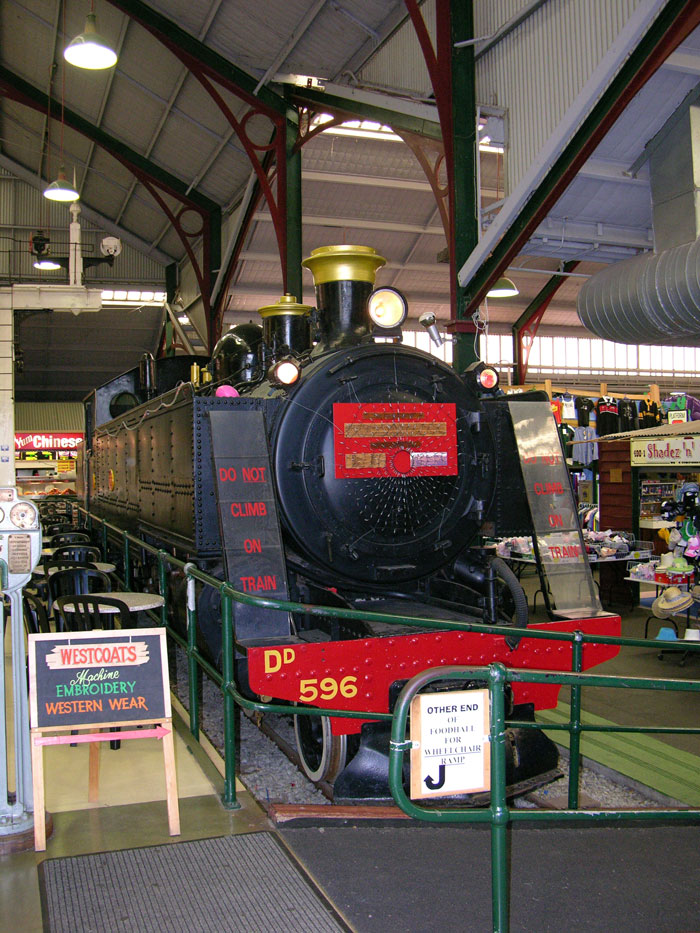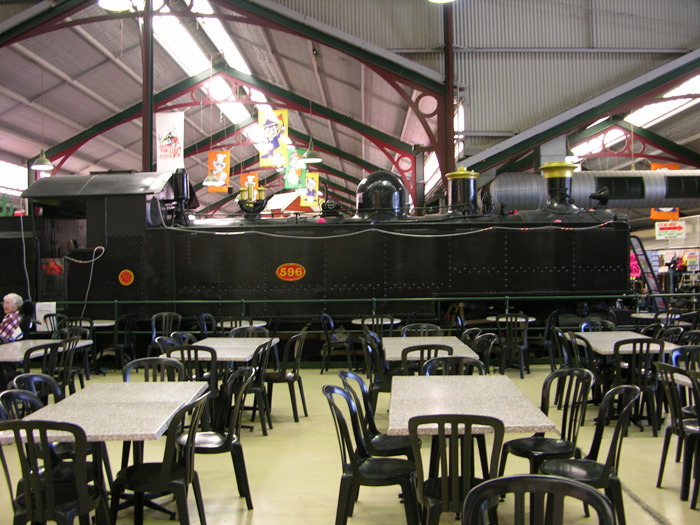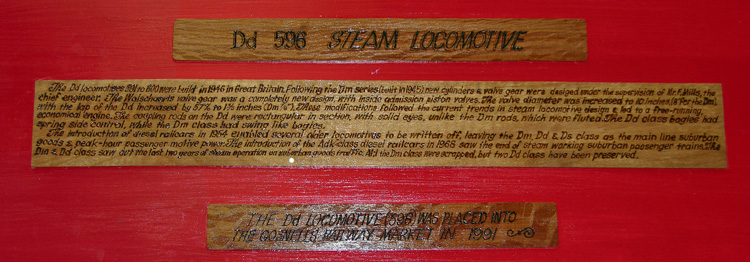
|
Dd 596 Centrepiece at Gosnells Railway Markets |

Dd 596 at the Gosnells Railway Markets in Perth, surrounded by stalls and dining tables etc.
The locomotive is well presented and the headlights and marker lights have been wired for operation.
This locomotive was built by the WAGR Midland Workshops in 1946 as one of 10 "Dd-class" 4-6-4T locomotives for Perth Suburban passenger duties. The Dd class represented the final development of the original design for 20 D-class 4-6-4T locomotives built by the North British Locomotive Company, Glasgow and supplied to the WAGR in 1912. Most of the D-class locomotives were later superheated to become the Ds-class. In addition, eight E-class pacific tender locomotives were rebuilt by the WAGR Midland Workshops in 1945 to become the Dm-class 4-6-4T locomotives. Today the only survivors of this family are Dd 592 and Dd 596 of the final Dd variant.
Dd 596 was purchased by the Australian Railway Historical Society (WA division) in 1974 with the intention of restoration to operation for tour train duties, however inspections in 1983 showed the boiler to be uneconomic to repair and accordingly sister Dd 592 was overhauled instead. Dd 596 was restored to static display standard in 1989 and plinthed at the Gosnells Railway Market in 1990.
The information board attached to the smokebox of Dd 596 provides further background to this family of locomotives:
"The Dd locomotives 591 to 600 were built in 1946 in Great Britain. (sic - the original 20 D-class locomotives were built in Great Britain, the Dm-class were rebuilt from E-class Pacifics at Midland Workshops, and the Dd class were build new at Midland Workshops.) Following the Dm series (built in 1945) new cylinders and valve gear were designed under the supervision of Mr. F. Mills, the Chief Engineer. The Walschaerts valve gear was a completely new design, with inside admission piston valves. The valve diameter was increased to 10 inches (8" for the Dm) with the lap of the Dd increased by 57% to 1 3/8 inches (Dm 7/8"). These modifications followed the current trends in steam locomotive design & led to a free-running, economical engine. The coupling rods on the Dd were rectangular in section, with solid eyes, unlike the Dm rods, which were fluted. The Dd class bogies had spring side control, while the Dm class had swing link bogies.
The introduction of diesel railcars in 1954 enabled several older locomotives to be written off, leaving the Dm, Dd & Ds class as the main line suburban goods & peak-hour passenger motive power. The introduction of the Adk-class diesel railcars in 1968 saw the end of steam working suburban passenger trains. The Dm & Dd class saw out the last two years of steam operation on suburban goods traffic. All the Dm class were scrapped, but two Dd class have been preserved."
My thanks to Jennifer Cassidy for contributing the photos of Dd 596 on this page, which were taken at the Gosnells Railway Markets on 8 October 2005.

The side tanks on the Dd & Dm class extended forward to the front of the smoke box, unlike the original D-class which extended only to smokebox rear.

The distinctive WAGR sand dome is evident behind the chimney.

A further view of Dd 596 at Gosnells Railway Markets.

This plaque is attached to the smokebox. The text is reproduced above.
References
|
a |
A. Gunzburg 'A history of WAGR steam locomotives', published by ARHS (Western Australian Division) 1984. |
|
b |
Gray. W. K., 'Guide to Rail Transport Museum, Bassendean, Western Australia', Australian Railway Historical Society W. A. Division, First Edition November 1999. |
Page updated: 4 February 2015